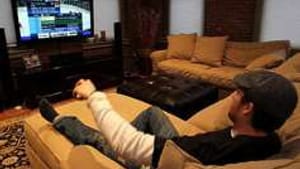Stay in the Loop
BSR publishes on a weekly schedule, with an email newsletter every Wednesday and Thursday morning. There’s no paywall, and subscribing is always free.
No girls allowed: The man cave as design challenge
The man cave as intimate space

The American Dream used to mean a house and a yard. In today's upwardly mobile society, as often as not, it means a personal hideaway: a country cottage, say, or a New Age barn, a rooftop garden, a hidden loft, a jazzed-up urban shack, a genuine gypsy wagon, a sit-down wine cellar or an electrified tree house— any intimate space that serves a homeowner's special (and often private) interests.
The fact that intimate spaces are usually separate from the main household is another good reason to include them in construction plans— especially when couples wish to avoid quarrels about how to use their rooms, and how to spend money for decorations.
The "man cave" is a case in point. This domestic phenomenon arose in the "'90s as a place where men could have their own separate retreats within homes whose designs were otherwise dominated by their wives.
Wall-to-wall porn
The earliest versions were converted basements, studios and garages. Here husbands and their men friends typically drank beer, watched sports on TV, collected memorabilia, and played cards with their pals. They established their rights to be on their own even if that meant smoking cigars, wall-to-wall pornography and pizza stains on the sofa.
In other words, just when many women were asserting their political, social and economic rights, men began designing these super-macho getaways. It was their way of saying, "It serves you right."
Today the "man cave" phenomenon receives more attention than any of the other intimate spaces I've mentioned above. Man cave specialist contractors offering a wide range of options. (My technological favorite is the cave with a hydraulic lift for the sports car lover who wants to use his garage as a shared space.) Man caves even have their own TV shows.
Darth Vader's example
During the last five or six years, the man cave evolved much beyond the personal party and sports bar motif. In fact, happily, this getaway has provided additional outlets for exceptional self-expression without leaving the home. Many former TV rooms have been turned into high-tech theaters, skillfully planned for family gatherings and big crowds. I found one modeled after Darth Vader's "Death Star." Another uses a recycled bank security door to keep out undesirables.
Although many men view the man cave as a private place no one should enter without their permission, women are no longer verboten, at least not on special occasions. Females began to be admitted either as guests or sex objects. The key point, it appears, is that women who cross the threshold implicitly consent to play by male rules rather their own.
Carnegie's favorite room
Of course men have always had their man caves; they just called them by different names: studies, workshops, libraries, dens, sheds or studios. Ernest Hemingway had his writing room, Mark Twain his writing hut, Frank Lloyd Wright his octagonal drafting studio. Although Andrew Carnegie was the world's richest man, his favorite place was his modest study. Thomas Jefferson kept his intimate space (which he called his boudoir, in the French style) under lock and key.
I've spent much of my career designing and decorating female visions of the home. I've yet to design a man cave, but I'd love to— assuming some man will trust me to invade his domain. And I'm sure someone will. The ultimate lesson of the man cave phenomenon is this: Men will trust women more if we let them have their way, at least in one teensy corner of their lives.
The fact that intimate spaces are usually separate from the main household is another good reason to include them in construction plans— especially when couples wish to avoid quarrels about how to use their rooms, and how to spend money for decorations.
The "man cave" is a case in point. This domestic phenomenon arose in the "'90s as a place where men could have their own separate retreats within homes whose designs were otherwise dominated by their wives.
Wall-to-wall porn
The earliest versions were converted basements, studios and garages. Here husbands and their men friends typically drank beer, watched sports on TV, collected memorabilia, and played cards with their pals. They established their rights to be on their own even if that meant smoking cigars, wall-to-wall pornography and pizza stains on the sofa.
In other words, just when many women were asserting their political, social and economic rights, men began designing these super-macho getaways. It was their way of saying, "It serves you right."
Today the "man cave" phenomenon receives more attention than any of the other intimate spaces I've mentioned above. Man cave specialist contractors offering a wide range of options. (My technological favorite is the cave with a hydraulic lift for the sports car lover who wants to use his garage as a shared space.) Man caves even have their own TV shows.
Darth Vader's example
During the last five or six years, the man cave evolved much beyond the personal party and sports bar motif. In fact, happily, this getaway has provided additional outlets for exceptional self-expression without leaving the home. Many former TV rooms have been turned into high-tech theaters, skillfully planned for family gatherings and big crowds. I found one modeled after Darth Vader's "Death Star." Another uses a recycled bank security door to keep out undesirables.
Although many men view the man cave as a private place no one should enter without their permission, women are no longer verboten, at least not on special occasions. Females began to be admitted either as guests or sex objects. The key point, it appears, is that women who cross the threshold implicitly consent to play by male rules rather their own.
Carnegie's favorite room
Of course men have always had their man caves; they just called them by different names: studies, workshops, libraries, dens, sheds or studios. Ernest Hemingway had his writing room, Mark Twain his writing hut, Frank Lloyd Wright his octagonal drafting studio. Although Andrew Carnegie was the world's richest man, his favorite place was his modest study. Thomas Jefferson kept his intimate space (which he called his boudoir, in the French style) under lock and key.
I've spent much of my career designing and decorating female visions of the home. I've yet to design a man cave, but I'd love to— assuming some man will trust me to invade his domain. And I'm sure someone will. The ultimate lesson of the man cave phenomenon is this: Men will trust women more if we let them have their way, at least in one teensy corner of their lives.
Sign up for our newsletter
All of the week's new articles, all in one place. Sign up for the free weekly BSR newsletters, and don't miss a conversation.

 Caroline Dunlop Millett
Caroline Dunlop Millett